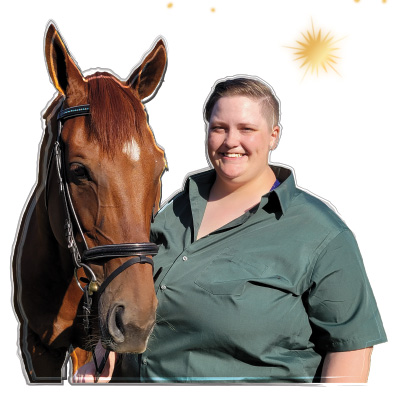

Collaborative clinical research and rolling hills of Kentucky blue grass—it’s what Dr. Marisa Henry imagines as the future owner of an equine rehabilitation center.

PhD, Comparative Medicine and Integrative Biology Program, College of Veterinary Medicine, Michigan State University, 2022
Currently pursuing Doctorate of Physical Therapy, School of Pharmacy and Health Professionals, Creighton University, 2025 (expected)
“I would love a massive facility out in the middle of Kentucky—indoor and outdoor stalls, aqua treadmills, high-speed treadmills, walkers—I think I have envisioned a $3 million facility,” says Henry. “But I want to be able to take horses in; I want to be the referral center. When your vet comes out to diagnose, I want them to say, ‘Take it to Dr. Henry. She’s the person who’s going to fix your horse.’”
She’s well on her way; Henry earned her PhD through the MSU College of Veterinary Medicine’s Comparative Medicine and Integrative Biology Program. Her dissertation research focused on how nutritional supplements—N-Acetyl Cysteine, Coenzyme Q10, and branched chain amino acids—may prevent or mitigate equine conditions or myopathies, as well as add support for healthy horses. Specifically, Henry’s research aimed to use the nutritional supplementation to enhance cellular concentrations of glutathione, an antioxidant vital for cellular function, and other antioxidants to determine if these supplements could help patients with equine myofibrillar myopathy, an exercise intolerance disease.
Henry determined that further investigation was warranted, as she observed no impairment in exercise or training response. Due to the nature of the racing industry, Henry only studied healthy horses.
“The racing industry has a lot of regulations around supplements and drugs, so being able to test them in actual racehorses could be quite difficult. We were incredibly lucky to work with Kentucky Equine Research to perform these trials with their research horses that are in race training. However, equine research is not like in human research. During my PhD, I took some human medicine classes, and we read incredible papers with funding that you just don’t typically get on the animal side. And human studies have N’s [sample sizes] of 100, 200, 300, 1,000, 2,000—my biggest N for all my studies was 7.”Henry has one stop left on her academic journey. In fall of 2022, she entered Creighton University’s Doctor of Physical Therapy program.
“I don’t feel like I’m ready to do anything yet. I have a lot of knowledge, but I don’t know how to use it clinically,” says Henry. “In veterinary school, you can do a little bit of rehabilitation study—but it’s a little bit, whereas physical therapy school is three years dedicated just to rehabilitation. So, this is a switch to humans. My ultimate goal is to utilize the human medicine and integrate it into horse medicine.”
Physical therapy school will tie everything together for Henry’s future in rehabilitation. For clinical research, she’ll have access to a population of horses with the same or similar injuries and conditions (likely spread across time), which offers an opportunity to collaborate with benchtop researchers in higher education. Henry also plans to connect a robust network of discipline-specific trainers—racing, eventing, dressage—and veterinarians to support her work.
“I won’t be a vet, so having those people in my corner is crucial,” says Henry.
Henry once considered equine sports medicine or large animal veterinary medicine with rehabilitation specialization. But working with Dr. Stephanie Valberg, Mary Anne McPhail Dressage Chair in Equine Sports Medicine and professor for the MSU Department of Large Animal Clinical Sciences, helped her realize the potential of different pathways.
“I was this shy, little freshman, and it was the most non-interview interview ever,” says Henry, as she recalls her earliest days with Valberg. “She said she would give me a tour of the lab, and we were both riding at the same barn, so we just started talking about horses and riding. She said, ‘I think you’ll work out here.’”
Henry stayed on with Valberg to pursue a master’s degree—or so she thought. “Dr. Valberg and I had a really long conversation. She told me, ‘Be careful when you look at other labs, reach out to people who work there to see how it runs—not every lab is as open and cool as we are.’ And it’s true! Our undergrads had projects within a few months of starting; that’s not normal. Usually, they’re doing dishes or organizing, but she always tried to make sure any student had a project within a few months.”
Valberg pointed out her laboratory’s heavy project load and another big project coming down the pike, which she wanted Henry to design. “I thought, ‘This is a really good opportunity. I know the lab; I know she’s looking out for me. Let’s do that.’”
Henry stuck with Valberg, and eventually switched to a PhD program. “Since working with Dr. Valberg, I’ve realized there’s a lot of ways to get there because there is no direct path.”